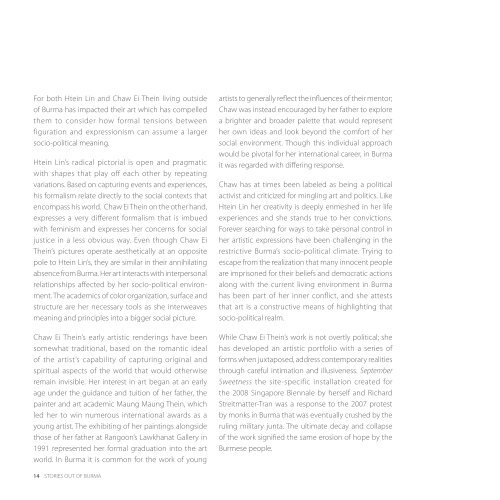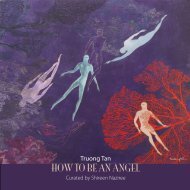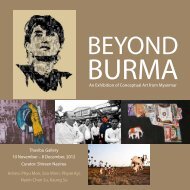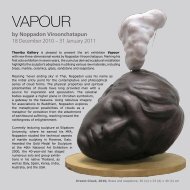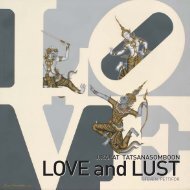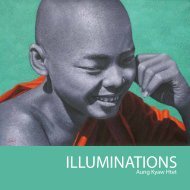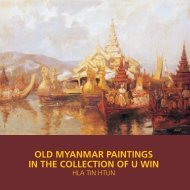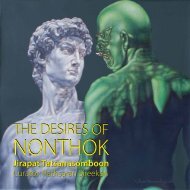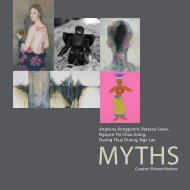CHAW EI THEIN and HTEIN LIN - Thavibu Gallery
CHAW EI THEIN and HTEIN LIN - Thavibu Gallery
CHAW EI THEIN and HTEIN LIN - Thavibu Gallery
Create successful ePaper yourself
Turn your PDF publications into a flip-book with our unique Google optimized e-Paper software.
For both Htein Lin <strong>and</strong> Chaw Ei Thein living outside<br />
of Burma has impacted their art which has compelled<br />
t h e m t o c o n s i d e r h o w f o r m a l t e n s i o n s b e t w e e n<br />
f i g u r a t i o n a n d e x p r e s s i o n i s m c a n a s s u m e a l a r g e r<br />
socio-political meaning.<br />
Htein Lin’s radical pictorial is open <strong>and</strong> pragmatic<br />
with shapes that play off each other by repeating<br />
variations. Based on capturing events <strong>and</strong> experiences,<br />
his formalism relate directly to the social contexts that<br />
encompass his world. Chaw Ei Thein on the other h<strong>and</strong>,<br />
expresses a very different formalism that is imbued<br />
with feminism <strong>and</strong> expresses her concerns for social<br />
justice in a less obvious way. Even though Chaw Ei<br />
Thein’s pictures operate aesthetically at an opposite<br />
pole to Htein Lin’s, they are similar in their annihilating<br />
absence from Bur ma. Her ar t interac ts with inter personal<br />
relationships affected by her socio-political environment.<br />
The academics of color organization, surface <strong>and</strong><br />
structure are her necessary tools as she interweaves<br />
meaning <strong>and</strong> principles into a bigger social picture.<br />
Chaw Ei Thein’s early artistic renderings have been<br />
somewhat traditional, based on the romantic ideal<br />
of the artist’s capability of capturing original <strong>and</strong><br />
spiritual aspects of the world that would otherwise<br />
remain invisible. Her interest in art began at an early<br />
age under the guidance <strong>and</strong> tuition of her father, the<br />
painter <strong>and</strong> art academic Maung Maung Thein, which<br />
led her to win numerous international awards as a<br />
young artist. The exhibiting of her paintings alongside<br />
those of her father at Rangoon’s Lawkhanat <strong>Gallery</strong> in<br />
1991 represented her formal graduation into the art<br />
world. In Burma it is common for the work of young<br />
artists to generally reflect the influences of their mentor;<br />
Chaw was instead encouraged by her father to explore<br />
a brighter <strong>and</strong> broader palette that would represent<br />
her own ideas <strong>and</strong> look beyond the comfort of her<br />
social environment. Though this individual approach<br />
would be pivotal for her international career, in Burma<br />
it was regarded with differing response.<br />
Chaw has at times been labeled as being a political<br />
activist <strong>and</strong> criticized for mingling art <strong>and</strong> politics. Like<br />
Htein Lin her creativity is deeply enmeshed in her life<br />
experiences <strong>and</strong> she st<strong>and</strong>s true to her convictions.<br />
Forever searching for ways to take personal control in<br />
her artistic expressions have been challenging in the<br />
restrictive Burma’s socio-political climate. Trying to<br />
escape from the realization that many innocent people<br />
are imprisoned for their beliefs <strong>and</strong> democratic actions<br />
along with the current living environment in Burma<br />
has been part of her inner conflict, <strong>and</strong> she attests<br />
that art is a constructive means of highlighting that<br />
socio-political realm.<br />
While Chaw Ei Thein’s work is not overtly political; she<br />
has developed an artistic portfolio with a series of<br />
forms when juxtaposed, address contemporary realities<br />
through careful intimation <strong>and</strong> illusiveness. S eptember<br />
Sweetness the site-specific installation created for<br />
the 2008 Singapore Biennale by herself <strong>and</strong> Richard<br />
Streitmatter-Tran was a response to the 2007 protest<br />
by monks in Burma that was eventually crushed by the<br />
ruling military junta. The ultimate decay <strong>and</strong> collapse<br />
of the work signified the same erosion of hope by the<br />
Burmese people.<br />
14 STORIES OUT OF BURMA


